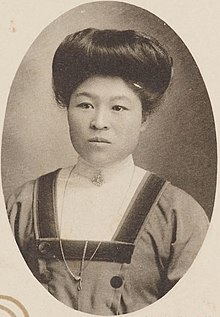| Inokuchi Akuri | |
|---|---|
 Inokuchi Akuri, from a photograph taken before 1912. Inokuchi Akuri, from a photograph taken before 1912. | |
| Born | January 12, 1871 Akita |
| Died | March 26, 1931 |
| Other names | Inoguchi Aguri, Fujita Akuri, Akuri Inokuchi |
| Occupation | Physical educator |
Inokuchi Akuri (井口阿くり) (January 12, 1871 – March 26, 1931) was a Japanese physical educator.
Early life
Inokuchi Akuri was born in Akita Prefecture. Sponsored by the Japanese government, she attended Smith College and Wellesley College, and studied physical education with Senda Berenson at the Boston Normal School of Gymnastics, founded by Mary Tileston Hemenway. "There is a great desire to make women strong in Japan," she explained to a Boston newspaper in 1901, "and so my government sent me over here to study how to increase our women's strength."
Career

Inokuchi was a teacher in Tokyo before her time in the United States. On her return to Japan in 1903, Inokuchi taught physical education at Girls' High School in Tokyo, and introduced a women's exercise costume of bloomers and middy blouses and calf-length skirts, for comfortable vigorous movement. She published a report, Taiiku no riron oyobi jissai (Theory and Practice of Physical Education) in 1906. She is considered one of the pioneers of women's modern physical education in Japan.
Inokuchi also taught in the imperial household for a time, and was head of a girls' school in Taipei.
Personal life
Inokuchi married in 1911, and was known as Fujita Akuri. The couple spent a brief time living in San Francisco, and in the 1920s she traveled to London as a tutor. She died in 1931, aged 60 years.
References
- "Athletics for Jap Girls; the Mission of Akuri Inokuchi, Who is Spending a Season in Japan". The Kansas City Star. 1902-04-06. p. 12. Retrieved 2020-10-05 – via Newspapers.com.
- "Aguri Inokuchi (1902)". Wellesley College. Retrieved 2020-10-05.
- Willms, Nicole (2017). "'Women Who Took Sports Beyond Play': How Japanese American Women's Basketball Went to College". In Messner, Michael; Hartmann, Douglas (eds.). When Women Rule the Court: Gender, Race, and Japanese American Basketball. Rutgers University Press. p. 107. ISBN 978-0-8135-8416-4. JSTOR j.ctt1q1cqp2.
- ^ Coates, Jennifer; Fraser, Lucy; Mark, Pendleton (2019-11-15). The Routledge Companion to Gender and Japanese Culture. Routledge. ISBN 978-1-351-71678-9.
- "This Japanese Girl Was Taught in Boston". The Boston Globe. 1906-08-19. p. 46. Retrieved 2020-10-05 – via Newspapers.com.
- "Knowledge for Japan". The Boston Globe. 1901-11-10. p. 48. Retrieved 2020-10-05 – via Newspapers.com.
- Mortimer, Alice W. (1902-11-22). "The New Women of Japan". The Bangor Daily News. p. 8. Retrieved 2020-10-05 – via Newspapers.com.
- Kasuga, Yoshimi; Tomozoe, Hidenori (2019). "Historical Research on the Promotion of Women's Physical Education in Prewar Japan: With a Focus on the Taisho Era*". International Journal of Sport and Health Science. 17: 32–44. doi:10.5432/ijshs.201812. ISSN 1348-1509.
- Ikeda, Keiko (2010-03-01). "Ryōsai-kembo, Liberal Education and Maternal Feminism under Fascism: Women and Sport in Modern Japan". The International Journal of the History of Sport. 27 (3): 537–552. doi:10.1080/09523360903556840. ISSN 0952-3367. S2CID 144790795.
- "Unodokai (Sports Day), c. 1930", Old Tokyo.
- Guttmann, Allen; Thompson, Lee (2001). Japanese Sports: A History. University of Hawai'i Press. p. 93. ISBN 978-0-8248-2414-3. JSTOR j.ctt6wqsmj.
- Cambridge, Nicolas (2011). "Cherry-Picking Sartorial Identities in Cherry-Blossom Land: Uniforms and Uniformity in Japan". Journal of Design History. 24 (2): 104–105. doi:10.1093/jdh/epr005. ISSN 0952-4649. JSTOR 23020370.
- Kietlinski, Robin. Japanese Women and Sport: Beyond Baseball and Sumo (Bloomsbury Academic 2011): 132-133.
- Chin, Hsiang Pin (2012-04-01). "Foot binding and physical education: the development of female physical education in Taiwan schools during the early years of Japanese rule (1895–1915)". Asia Pacific Journal of Sport and Social Science. 1 (1): 37–47. doi:10.1080/21640629.2012.681861. ISSN 2164-0599.
- Wellesley College (1919). Bulletin. p. 31.